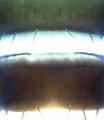Thrips trehernei
Recognition data
Distinguishing features
Both sexes fully winged. Body and legs brown, tarsi and apex of fore tibiae yellow; antennal segments I–II dark brown, VI–VII light brown, III–V mainly yellow with apices shaded; fore wings light brown. Head as wide as long, 2 pairs of ocellar setae; pair III small, arising on anterior margins of ocellar triangle; postocular setae I & III longer than II & IV. Antennae 7-segmented; segments III–IV with sensorium forked. Pronotum with transverse lines of sculpture; 2 pairs of posteroangular setae, 3 pairs of posteromarginal setae. Metanotum with narrow longitudinal reticulation on posterior half, irregular lines at anterior; median setae close to anterior margin; campaniform sensilla absent. Fore wing first vein with 3 setae on distal half; second vein with row of about 12 setae. Abdominal tergite II with 3 lateral marginal setae; V–VIII with paired ctenidia, on VIII posteromesad to spiracles; tergite VIII posteromarginal comb complete, microtrichia slender; pleurotergites without discal setae. Sternite II with 2 pairs of marginal setae, III–VII with 3 pairs; sternite II without discal setae, III–VII with about eight discal setae in irregular transverse row.
Male as dark as female but smaller; tergite VIII posterior margin with no comb; sternites III–VII with broadly oval pore plate.
Related and similar species
The genus Thrips is the second largest genus in the Thysanoptera, and currently includes, worldwide, about 285 species. The females of T. trehernei are very similar to the females of T. physapus Uzel, the common European species that is the type-species of this genus, but have slightly longer pronotal setae. However, the males of T. physapus are yellow, whereas those of T. trehernei are brown. All members of genus Thrips lack ocellar setae I on the head, and they all have ctenidia on tergite VIII posteromesad to the spiracles. Other characters, such as number of antennal segments, number of setae on the fore wing veins, and number of discal setae on the sternites are variable between species (Palmer, 1992; Nakahara, 1994; Mound & Masumoto, 2005).
Taxonomic data
Current valid name
Thrips trehernei Priesner
Original name and synonyms
- Thrips trehernei Priesner, 1927: 356
- Thrips magna Priesner, 1927: 355
- Thrips taraxaci Moulton, 1936: 109
- Thrips hukkineni Priesner, 1937: 108
Family placement
Thripidae, Thripinae
Biological data
Life history
Breeding in flowers.
Host plants
Various species of Asteraceae.
Tospoviruses vectored
None
Crop damage
None
Distribution data
Area of origin
Either Holarctic, or possibly western Europe.
Distribution
Widespread across Europe and in North America as far south as Georgia and California, also Hawaii (Nakahara, 1994); southeastern Australia (Mound, 1998).







